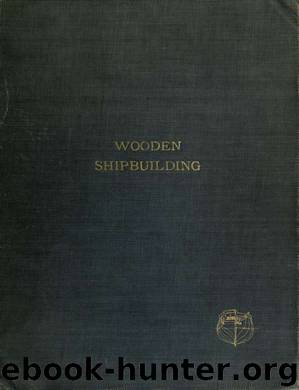Wooden ship-building by Desmond Charles

Author:Desmond, Charles
Language: eng
Format: epub
Publisher: New York, Rudder Pub. Co
^-'f^'wi[»p^'i^r^si w\ mm. MHi \'>i^rm' '' ''^'^^Wm'w^%Kw\m\m
MM-»^ ^=i
Fig. 86. Trussed Wood Kaalson
WOODEN SHIP-BUILDING
97
hang in place. Sheer planks are sawed to shape, beveled, hung and fastened in manner explained in garboard paragraph.
The wales, as you will note by referring to Figs. 28 and 201 and Table 3E (page 22), are somewhat thicker than bottom planking. The proper vertical extent of wales on vessels of usual proportion of depth to length is about one-third of vessel's depth of hold, but when a vessel is eight or more depths in length it is usual to increase vertical depth of wales to about two-fifths of depth of hold. Method of getting out and fastening wales is similar to that of balance of planking.
■ In all cases the outside planking of a vessel must be put on in as long lengths as possible, because butts tend to weaken longitudinal strength of planking. While I am referring to butts, I will mention some safe rules to following in locating butts.
1st.—All planking butts should come on middle of a frame and should be cut accurately and fastened securely.
2d.—Butts of adjoining planks should not be nearer each other, in a longitudinal direction, than three frames, and two butts should not come on the same frame unless at least three full strakes of planking are between.
It is advisable when a vessel is planked with fir or yellow pine to make the after hoods of planks along the "tuck" and the forward hoods of bow planks that will require a great deal of twisting to get them in place, of white oak. Another detail of importance is to get out all planks with the required curvature, and thus do away with any necessity of having to "force" the planks edgeways in order to make them fit snug against the adjacent plank. "Edge-setting" a plank is a detriment and will sometimes result in the plank breaking after it has been fastened in place.
loP. Fastenings of Planking
The number, sizes, and kinds of planking fastenings to use are given on Tables 3B, 3C, 3D, 3E, 3F (pages 20 to 23), and methods of fastening are shown on Figs. 45 and 46.
Three kinds of fastenings are used for securing outside planking of a vessel's frame. Wood treenails, through bolts zvith nuts and clinch bolts (bolts whose ends can be clinched or riveted over clinch rings or washers).
Number of planking fastenings should always be proportioned to width of strake of plank.
Planks above 11 inches must have at least two fastenings into each frame, called double fastening. Planks over 8 inches and up to 11 inches must have alternate dou])le and single fastenings; that is, have two fastenings in one frame and one fastening in adjacent one.
Planks under 8 inches in width can be single fastened; that is, have one fastening driven through each frame.
All butts' of planks must be fastened with at least two bolts going through the timber on which butt is cut and one bolt through each adjacent timber. These butt bolts must be riveted or have nuts set up on washers.
Download
This site does not store any files on its server. We only index and link to content provided by other sites. Please contact the content providers to delete copyright contents if any and email us, we'll remove relevant links or contents immediately.
On Writing A Memoir of the Craft by Stephen King(4664)
The Doodle Revolution by Sunni Brown(4503)
A Simplified Life by Emily Ley(3969)
Mummy Knew by Lisa James(3521)
Marijuana Grower's Handbook by Ed Rosenthal(3512)
Better Homes and Gardens New Cookbook by Better Homes & Gardens(3371)
Paper Parties by Erin Hung(3308)
Figure Drawing for Artists by Steve Huston(3272)
Draw Your Day by Samantha Dion Baker(3127)
The Genius of Japanese Carpentry by Azby Brown(3040)
Japanese Design by Patricia J. Graham(3000)
The Code Book by Simon Singh(2857)
Lions and Lace by Meagan Mckinney(2846)
Dangerous Girls by Haas Abigail(2840)
The Curated Closet by Anuschka Rees(2803)
How to Make Your Own Soap by Sally Hornsey(2741)
The Checklist Manifesto by Atul Gawande(2657)
The Wardrobe Wakeup by Lois Joy Johnson(2635)
Zero to Make by David Lang(2627)
